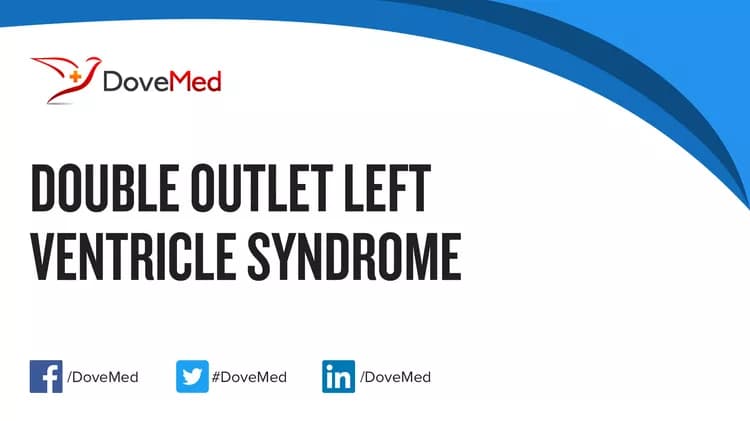What are the other Names for this Condition? (Also known as/Synonyms)
- DOLV (Double Outlet Left Ventricle)
- DOLV Syndrome
- Double Outlet Left Ventricle (DOLV)
What is Double Outlet Left Ventricle Syndrome? (Definition/Background Information)
- Double Outlet Left Ventricle (DOLV) Syndrome is an extremely rare congenital cardiac malformation in which both the aorta and the pulmonary artery arise, either exclusively or predominantly, from the morphologic left ventricle
- DOLV occurs most commonly in the form of atrial situs solitus with atrioventricular (AV) concordance but is often associated with cardiac anomalies such as a ventricular septal defect (VSD), an atrial septal defect, pulmonary stenosis, right ventricular hypoplasia, patent ductus arteriosus, and tricuspid atresia
- The clinical manifestations depend largely on the type of the associated cardiac defects, e.g. pulmonary or aortic outflow tract obstruction resulting from pulmonary or aortic valve stenosis respectively
- Double Outlet Left Ventricle is classified into two sub-types depending on the location of the VSD and the position of the great arteries:
- DOLV with normal great arteries (DOLV NGA type) with subpulmonary or doubly-committed subarterial VSD and levo-position of the anterior pulmonary artery
- And, DOLV with transposition of the great arteries (DOLV TGA type) with subaortic or doubly-committed subarterial VSD and levoposition of the anterior aorta
- The two sub-types are almost clinically indistinguishable, apart from cyanosis being more prominent in TGA type
(Source: Double Outlet Left Ventricle; Orphanet, National Institute of Health and Medical Research (INSERM), Paris.)
Who gets Double Outlet Left Ventricle Syndrome? (Age and Sex Distribution)
- Double Outlet Left Ventricle Syndrome is a rare congenital disorder of unknown prevalence. The rate of occurrence is about 1 in 200,000
- The presentation of symptoms may occur at birth
- Both males and females may be affected
- Worldwide, individuals of all racial and ethnic groups may be affected
What are the Risk Factors for Double Outlet Left Ventricle Syndrome? (Predisposing Factors)
- Currently, no risk factors have been clearly identified for Double Outlet Left Ventricle Syndrome
It is important to note that having a risk factor does not mean that one will get the condition. A risk factor increases one’s chances of getting a condition compared to an individual without the risk factors. Some risk factors are more important than others.
Also, not having a risk factor does not mean that an individual will not get the condition. It is always important to discuss the effect of risk factors with your healthcare provider.
What are the Causes of Double Outlet Left Ventricle Syndrome? (Etiology)
- The cause for Double Outlet Left Ventricle Syndrome is not clearly understood
- Embryologically, DOLV could result from excessive leftward shift of the embryonic conotruncus, anomalous differential absorption of sub-pulmonic and sub-aortic conus, or anomalous differential conal growth
(Source: Double Outlet Left Ventricle; Orphanet, National Institute of Health and Medical Research (INSERM), Paris.)
What are the Signs and Symptoms of Double Outlet Left Ventricle Syndrome?
The signs and symptoms of Double Outlet Left Ventricle Syndrome may include:
- Cyanosis
- Tachypnea
- Exertional dyspnea
- Failure to thrive
- Sweating (especially during feeding)
- Unresponsiveness and/or fatigue
- Arrhythmia
- Aortic valve regurgitation
- Mitral valve regurgitation
- Hypertension
(Source: Double Outlet Left Ventricle; Orphanet, National Institute of Health and Medical Research (INSERM), Paris.)
How is Double Outlet Left Ventricle Syndrome Diagnosed?
- The diagnosis of Double Outlet Left Ventricle Syndrome is based on 2-D echocardiography combined with magnetic resonance imaging (MRI) showing both great arteries arising from the morphologic left ventricle
- Chest X-ray and/or cardiac catheterization can also be performed
(Source: Double Outlet Left Ventricle; Orphanet, National Institute of Health and Medical Research (INSERM), Paris.)
Many clinical conditions may have similar signs and symptoms. Your healthcare provider may perform additional tests to rule out other clinical conditions to arrive at a definitive diagnosis.
What are the possible Complications of Double Outlet Left Ventricle Syndrome?
The complications of Double Outlet Left Ventricle Syndrome may include:
- Breathing difficulties
- Heart failure
Complications may occur with or without treatment, and in some cases, due to treatment also.
How is Double Outlet Left Ventricle Syndrome Treated?
The following are some treatment methods for Double Outlet Left Ventricle Syndrome:
- Biventricular repair is the usual treatment for DOLV and is usually accomplished by an intraventricular baffle procedure, by the Rastelli procedure or by a variant of the Lecompte operation
- Pulmonary root translocation from the left to the right ventricle can also be performed and provides excellent anatomic and hemodynamic repair
- When other cardiac malformations are present, other techniques can be used such as Fontan-type cavopulmonary derivation in the presence of right ventricular hypoplasia
(Source: Double Outlet Left Ventricle; Orphanet, National Institute of Health and Medical Research (INSERM), Paris.)
How can Double Outlet Left Ventricle Syndrome be Prevented?
- Double Outlet Left Ventricle Syndrome may not be preventable, since the cause of this congenital disorder is unknown
- Regular medical screening at periodic intervals with tests and physical examinations are recommended
What is the Prognosis of Double Outlet Left Ventricle Syndrome? (Outcomes/Resolutions)
- The prognosis of Double Outlet Left Ventricle Syndrome is poor, since it is associated with high mortality, generally due to heart failure, myocardial infarction or aortic thrombosis
- With surgery, the five-year survival rate is estimated at 70-75%
- Most patients will continue to present with residual cardiac anomalies, such as aortic or mitral valve regurgitation, arrhythmias or hypertension
(Source: Double Outlet Left Ventricle; Orphanet, National Institute of Health and Medical Research (INSERM), Paris.)
Additional and Relevant Useful Information for Double Outlet Left Ventricle Syndrome:
The following DoveMed website link is a useful resource for additional information:
Related Articles
Test Your Knowledge
Asked by users
Related Centers
Related Specialties
Related Physicians
Related Procedures
Related Resources
Join DoveHubs
and connect with fellow professionals


0 Comments
Please log in to post a comment.